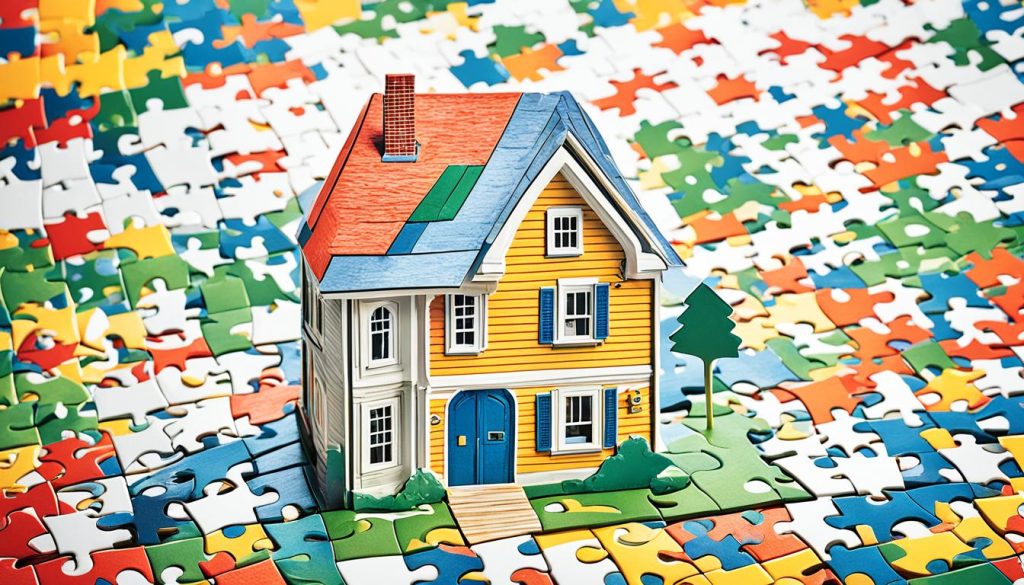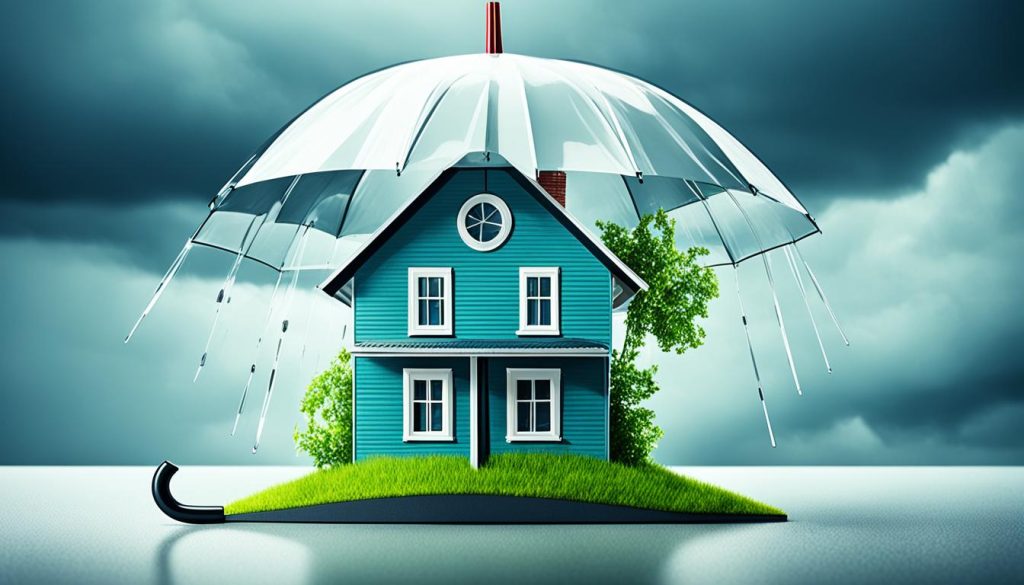Homeowners insurance helps protect your home and its contents from damage or loss1. It also covers you against accidents that happen at home or on your property. This insurance is key to avoid big financial losses and keep you calm. You can tailor your policy to fit your needs, like covering your home, belongings, and liability.
Key Takeaways
- Homeowners insurance protects your home and personal belongings from damage, theft, and liability claims.
- Policies can be customized to include coverage for your specific needs, such as dwelling protection, personal property, and liability.
- 1 Many homeowners choose to add optional coverages like flood insurance, umbrella liability, and additional living expenses.
- 2 Homeowners have several policy options to choose from, ranging from basic to comprehensive coverage.
- 3 Understanding the details of your homeowners policy, including limits and deductibles, is crucial to ensuring proper protection.
Understanding Property Insurance for Homeowners
What is Property Insurance for Homeowners?
Homeowners insurance is a type of coverage that protects your home, belongings, and you from liability. It usually covers your home’s structure, your stuff, and helps with living expenses if your home is not safe to live in because of an event4.
You can also get extra coverage for things like jewelry, earthquakes, and floods. These options help protect your home and things from specific risks not covered in basic policies4.
Lenders often ask for insurance that covers rebuilding your home if it’s destroyed4. Insurance companies look at your home’s history, the area it’s in, and its condition to set your rates4.
Most policies cover 50% to 70% of your stuff’s value4. Experts say you should have at least $300,000 in liability coverage. You can get more for a few hundred dollars more4.
There are three main types of homeowners insurance: Actual Cash Value, Replacement Cost, and Extended Replacement Cost/Value4. Some suggest getting Extended Replacement Cost/Value for full coverage, no matter the policy limit4.
Some disasters like floods and earthquakes aren’t covered by standard insurance4. Rates go up if you’re likely to file a claim. Things like the area’s crime rate and building materials affect your rates too4.
Some things like home maintenance, war, and certain disasters aren’t covered4. Your stuff is usually covered for 50% to 70% of your home’s insurance value. But, coverage for things outside your home is limited to 10% of your possessions’ value5.
There are limits on coverage for expensive items like jewelry and art if they get stolen5. Liability coverage helps with legal costs and awards up to your policy’s limit. Additional living expenses coverage might have limits and time rules5.
The most common home insurance is an HO-3 policy, covering your home and belongings against many issues6. Flood insurance doesn’t cover extra living expenses or loss of use if you have to leave your home6.
Most policies don’t cover flood or earthquake damage6. Your insurance costs depend on where you live, coverage limits, deductibles, claims history, and your home’s details6.
Insurance usually doesn’t cover damage from earthquakes, floods, or other specific events6. Policies can have “open perils” coverage or “named perils” coverage, which only covers listed losses6.
Key Coverages in a Homeowners Insurance Policy
A standard homeowners insurance policy offers several key coverages to protect your home and belongings7. These coverages include dwelling coverage, personal property coverage, other structures coverage, loss of use coverage, personal liability coverage, and medical payments coverage.
8 Dwelling coverage protects your home and attached buildings like a garage or porch against fire, theft, or severe weather9. It pays for repairs, replacements, or rebuilding after a covered event.
8 Personal property coverage covers your belongings like furniture, appliances, and clothes on a named peril basis9. You can add coverage for valuable items like jewelry or collectibles with a scheduled endorsement.
8 Other structures coverage protects detached buildings like a garage or shed, up to 10% of your dwelling coverage limit9. It helps pay for repairs or replacements if these structures are damaged by a covered event.
8 Loss of use coverage pays for extra living expenses if your home is uninhabitable due to a covered loss9. This includes costs for temporary housing, meals, and other necessary expenses while your home is being fixed.
8 Personal liability coverage covers you if someone gets hurt on your property and you’re legally liable9. It can pay for medical bills and legal fees if you’re sued.
8 Medical payments coverage covers minor injuries to people who get hurt on your property, even if you’re not at fault9. It helps pay for their medical expenses and copays.
7 It’s key to know about any limits, exclusions, policy limits, and deductibles in your homeowners insurance8. Understanding your policy ensures you have the right protection for your home and belongings.

“Protecting your home and personal belongings with a comprehensive homeowners insurance policy is crucial. Make sure you understand the key coverages and any limitations to ensure you have the right protection for your needs.”
Property Insurance for Homeowners
As a homeowner, you can make your property insurance better with extra coverages. These add-ons protect your home and stuff from many dangers10. They give you peace of mind and make sure your home and things are safe.
One great add-on is for scheduled personal property. It covers things like jewelry, art, and electronics that are worth a lot1. This is good if you have valuable items that need extra care.
You can also get coverage for sewer/water backups and earthquakes1. Windstorm coverage protects your home from damage from strong winds1.
Flood insurance is key because regular homeowners insurance doesn’t cover flood damage1. This coverage helps with losses from heavy rain, storm surges, and floods.
Identity theft coverage is also a smart choice. It covers costs from identity theft and helps fix your credit and identity1.
Law/ordinance coverage is good if your home needs updates to meet new building codes after a loss1. It helps pay for these extra costs.
Looking at your insurance options and picking the right coverages is smart11. This way, your home and things are safe from many risks. It’s a smart move for your wallet and peace of mind.
“Protecting your home is one of the most important investments you can make. By customizing your property insurance, you can ensure your home and belongings are safeguarded against unexpected events.”
Conclusion
Homeowners insurance is key to protecting your home, a big investment for many people12. It covers your home and belongings against damage or loss from various events12. By picking the right coverages, you can rebuild and replace what you lose if something happens12.
Working with an experienced agent helps you find the coverage you need12. They look at your situation and tailor a policy for you12. This is crucial because premiums vary a lot by location and coverage type13. With the right insurance, you’ll know your home is safe, even from unexpected disasters or accidents.
Insurance isn’t just needed by lenders; it’s crucial for protecting your home and your future12. Understanding insurance and working with an expert agent ensures you’re well-covered12. This way, you can keep your home safe and secure.
FAQ
What is homeowners insurance?
Homeowners insurance protects your home and stuff if they get damaged or lost. It also covers you if someone gets hurt at your place.
What does a standard homeowners insurance policy cover?
This policy usually covers your home, your stuff, and you if someone gets hurt at your place. It also helps with extra living costs if your home is not safe to live in.
What additional coverages can homeowners purchase?
You can buy extra coverage for special items, like jewelry or electronics. You can also get coverage for things like sewer backups or floods.
What is dwelling coverage in a homeowners policy?
Dwelling coverage helps fix or rebuild your home if it gets damaged by things like fire or storms.
What is personal property coverage in a homeowners policy?
This coverage protects your stuff, like your furniture and clothes, from damage or loss.
What is personal liability coverage in a homeowners policy?
This coverage protects you if someone gets hurt at your home. It also covers medical costs for minor injuries to visitors.
What is loss of use coverage in a homeowners policy?
Loss of use coverage pays for extra living costs if your home is not safe to live in because of damage.
What is scheduled personal property coverage?
This coverage is for special items like jewelry or art that are worth more than the basic policy covers.
What is the importance of working with an insurance agent for homeowners insurance?
An insurance agent helps you find the right policy for your needs. They make sure your home is well-protected.
Source Links
- Homeowners Insurance
- Homeowners Insurance: Choosing a Policy
- Basic Coverage and Adding Coverage
- Homeowners Insurance Guide: A Beginner’s Overview
- Understanding Basic Homeowners Insurance | Department of Insurance, SC
- What Is Property Insurance And How Does It Work?
- Residential Insurance: Homeowners and Renters
- No title found
- What Does Homeowners Insurance Cover?
- Homeowners Insurance Coverage | Easy Free Online Quotes
- Types Of Property Insurance For Your Home
- Do I Need Homeowners Insurance and When Should I Buy It? | Travelers Insurance
- Homeowners Insurance premium at Closing | What to Know | Credible

